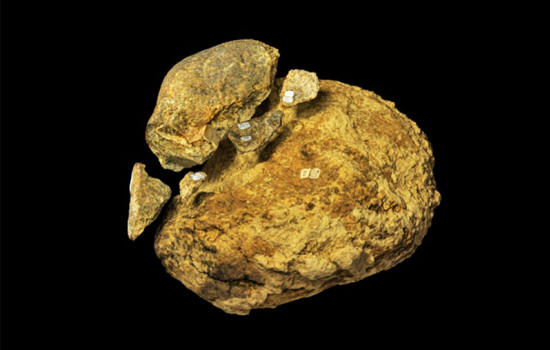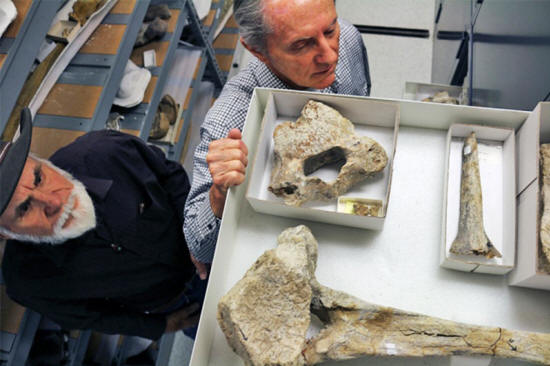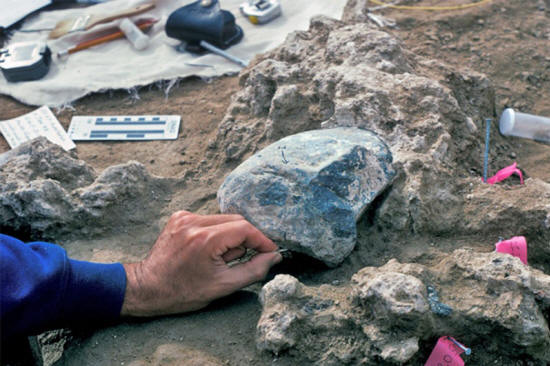|
by Ewen Callaway from Nature Website
- found in California and dated to 130,000 years ago.
A. Rountrey, C. Abraczinskas and D. Fisher/Univ. Michigan
hint that Homo sapiens wasn't the first hominin to get to the New World.
The jaw-dropping claim
made in Nature, 1 is based on broken rocks and mastodon
bones found in California that a team of researchers say point to
human activity. Their contention, if correct, would force a dramatic rethink of when and how the Americas were first settled - and who by.
Most scientists subscribe to the view that Homo sapiens arrived in North America less than 20,000 years ago.
The latest study (A 130,000-year-old Archaeological Site in southern California, USA) raises the possibility that another hominin species, such as Neanderthals or a group known as Denisovans, somehow made it from Asia to North America before that and flourished.
The study focuses on ancient animal-bone fragments found in 1992 during road repairs in suburban San Diego.
The find halted construction, and paleontologist Tom Deméré of the San Diego Natural History Museum led a five-month excavation. His crew uncovered teeth, tusks and bones of an extinct relative of elephants called a mastodon (Mammut americanum), alongside large broken and worn rocks.
The material was buried in fine silt left by flowing water, but Deméré felt the rocks were too large to have been carried by the stream.
Mastodon fossils from the California site (breakages pictured bottom right). Kate Johnson/SDNHM
Attempts in the 1990s to date the site suggested that the ivory was some 300,000 years old, but Deméré was skeptical:
Challenging consensus
Over the past decade, archaeological research and studies of modern and ancient DNA have reached a consensus view on the peopling of the Americas: humans from Asia crossed the Bering land bridge into Alaska some 20,000 years ago and reached the southern tip of South America around 14,000-15,000 years ago. 2
Some archaeologists, however, maintain that humans arrived earlier.
They point to sites containing rocks that resemble stone tools as well as large animal bones that have damage apparently inflicted by humans.
Deméré's co-authors Kathleen Holen and her husband Steven Holen, archaeologists at the Center for American Paleolithic Research in Hot Springs, South Dakota, have put forward several sites in the US Midwest as evidence for a human presence in the Americas up to 40,000 years ago. 3
But many scientists have viewed these claims with skepticism.
After hearing about the San Diego mastodon, the Holens visited Deméré in 2008 to see the boxed-up remains.
The bones looked as though they had been set on a large 'anvil' stone and struck with a 'hammer' rock.
The team contends that the rocks recovered from the site were used either to extract the mastodon's bone marrow or for making more-delicate bone tools.
There are no obvious cut marks on the mastodon bone, suggesting that the animal wasn't killed or butchered for its meat.
Using refined dating methods, the researchers tried again to determine the age of the site. They couldn't use radiocarbon dating on the mastodon remains because the bones lacked carbon-containing collagen protein.
A second method was too imprecise.
A third technique, which measures relative levels of radioactive uranium and thorium in bone, suggested that the remains are 130,000 years old.
A researcher holds a mastodon molar fragment found under a rock anvil discovered at the California site. SDNHM
Alistair Pike, an archaeological scientist at the University of Southampton who specializes in uranium dating, notes that the team's method relies on simplified models of how uranium seeps from groundwater into bone, but he sees no obvious flaws in the dating work.
Collecting ancient DNA from the remains and determining the animal's evolutionary relationship to other mastodons could also help to establish the site's age, notes Pontus Skoglund, a population geneticist at Harvard Medical School in Boston, Massachusetts, who works on ancient DNA. If the discovery holds up, he adds,
Eyebrow-raising claim
Before invoking humans, however, the researchers need to better rule out the possibility that natural forces broke the rocks and bones, says David Meltzer, an archaeologist at Southern Methodist University in Dallas, Texas.
McNabb would like to see the breakage patterns analyzed in more detail.
He finds it "curious" that the site yielded no other traces of human presence, such as the shaped stone tools that are typically found at much older animal-butchery sites in Africa.
Erella Hovers, an archaeologist at the Hebrew University of Jerusalem who reviewed the paper for Nature, says she raised her eyebrows when the manuscript arrived in her inbox:
But after revisions that elaborated on the dating work and demonstrated that hitting modern elephant bones with large rocks produces damage patterns similar to those seen on the mastodon bones, she is now convinced that hominins created the California site.
Who were the first Americans?
If humans or their ancient relatives were responsible, there are several candidates.
The ancestors of modern non-African humans left the continent less than 100,000 years ago, but earlier migrations out of Africa might have reached North America, Deméré and his co-authors say.
They point to 100,000-year-old Homo sapiens-like teeth from China and to hints that some indigenous groups in South America carry trace ancestry from a possible earlier migration into the Americas.
Chris Stringer, a palaeoanthropologist at the Natural History Museum in London, favors Denisovans or Neanderthals, which both lived in southern Siberia at least 100,000 years ago.
Yet there is no evidence that either group could survive the epic Arctic voyage across from Siberia to Alaska.
Steven Holen hopes that other scientists will join the search.
References
|




